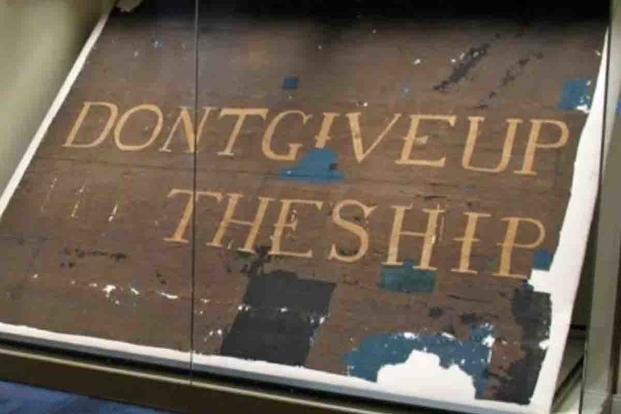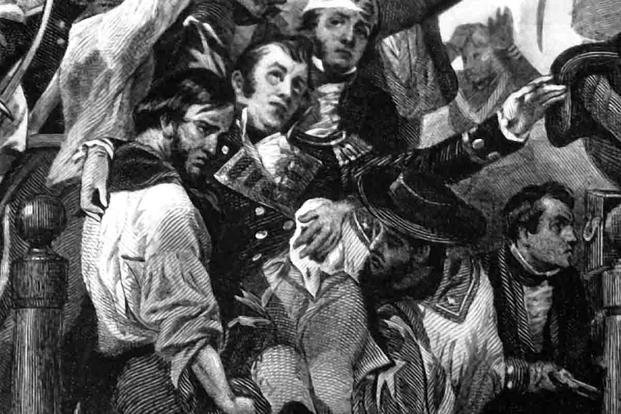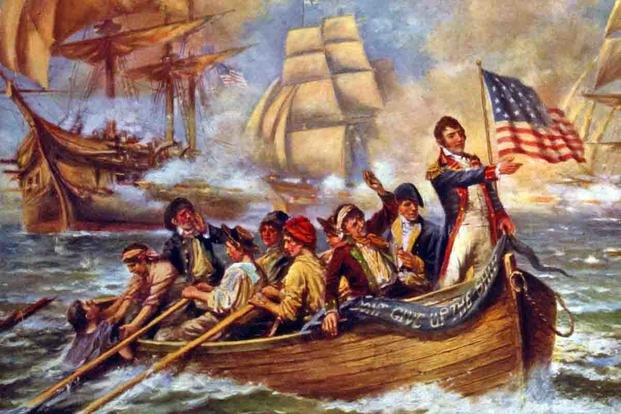In the U.S. Naval Academy's Memorial Hall rests a flag with a dark background and bright letters that read: "Dont Give Up The Ship." The flag is only a replica of the original, which was preserved in the hall from 2002 until 2009.
The original flag was the battle standard of U.S. Navy legend Oliver Hazard Perry, who first raised it aboard his flagship, the USS Lawrence, in September 1813. Since that day, it has served as a rallying cry for American sailors -- and helped give birth to another famous Navy quote.

USS Lawrence was named for Capt. James Lawrence, who took command of the USS Chesapeake during the War of 1812. He sailed the frigate out of Boston on June 1, 1813, and headed straight for the Royal Navy, which was then blockading the coast of New England.
British Capt. Philip Vere Broke of the HMS Shannon challenged Lawrence to single-ship combat outside of Boston Harbor, and the Americans were eager to oblige him. The fight was a bloody one, literally. For 15 violent minutes, the decks of the Chesapeake were peppered with grape and canister shot at close range.
A total of 146 American sailors were killed in the engagement, including Lawrence, who was hit with the canister shot. Before dying, he issued his last order: "Don't give up the ship. Fight her ‘til she sinks." Try as they might, the Americans could not fight off a British boarding party, and the Chesapeake was captured. It was taken back to Halifax in Canada as a prize.

Lawrence's good friend and fellow naval officer, Oliver Hazard Perry, first learned about Lawrence's death when he arrived at Presque Isle, Pennsylvania, on Lake Erie. There, the Americans were building a fleet to challenge British supremacy on the lakes.
Perry was in command of the American squadron on Lake Erie. Over the course of the summer of 1813, the British blockade of Presque Isle was lifted, and Perry moved his fleet out of anchorage. Perry, in turn, blockaded the British fleet on the Great Lakes and forced its commander, Cmdr. Robert H. Barclay, into a pitched action.
On Sept. 10, 1813, Perry raised his battle flag, with the words "Dont Give Up The Ship" emblazoned on a dark background, on his flagship, the USS Lawrence, and sailed to meet the British fleet.
When the two forces formed their lines of battle, the British had the weather gauge, meaning they were upwind and could control the movement of the battle -- a significant advantage. During the fighting, the wind changed, giving the Americans the upper hand. American gunboats raked the British ships from a long distance, but the Lawrence was disabled.
Perry, aboard the Lawrence, had tried to get the ship within close range of the HMS Detroit, but was battered by the ship's longer guns. The Lawrence was eventually disabled, 80% of its crew wounded or killed and had only one working cannon. Perry took down his battle flag and rowed with a handful of crewmembers to the USS Niagara, under heavy fire, for a half-mile to continue the fight.

The Lawrence had been forced to surrender, but after three hours of fighting, the bulk of the British ships were heavily damaged and unable to maneuver. Barclay, with ships adrift, a third of his men wounded or killed and himself injured, gave up as the Americans began to clean up what little resistance the British had left.
Although Perry had transferred to the Niagara during the battle, he received the British surrender aboard the USS Lawrence. With the United States in control of Lake Erie, Perry sent a message to U.S. Army Gen. William Henry Harrison: "We have met the enemy and they are ours."
-- Blake Stilwell can be reached at blake.stilwell@military.com. He can also be found on Twitter @blakestilwell or on Facebook.
Want to Learn More About Military Life?
Whether you're thinking of joining the military, looking for post-military careers or keeping up with military life and benefits, Military.com has you covered. Subscribe to Military.com to have military news, updates and resources delivered directly to your inbox.
















